Nateglinide
Editor-In-Chief: C. Michael Gibson, M.S., M.D. [1]; Associate Editor(s)-in-Chief: Adeel Jamil, M.D. [2]
Disclaimer
WikiDoc MAKES NO GUARANTEE OF VALIDITY. WikiDoc is not a professional health care provider, nor is it a suitable replacement for a licensed healthcare provider. WikiDoc is intended to be an educational tool, not a tool for any form of healthcare delivery. The educational content on WikiDoc drug pages is based upon the FDA package insert, National Library of Medicine content and practice guidelines / consensus statements. WikiDoc does not promote the administration of any medication or device that is not consistent with its labeling. Please read our full disclaimer here.
Overview
Nateglinide is a antidiabetic , endocrine metabolic-hypoglycemic agent and meglitinide that is FDA approved for the treatment of type 2 diabetes mellitus. Common adverse reactions include hypoglycemia and upper respiratory infection.
Adult Indications and Dosage
FDA-Labeled Indications and Dosage (Adult)
- Starlix® (nateglinide) is indicated as an adjunct to diet and exercise to improve glycemic control in adults with type 2 diabetes mellitus.
Dosing Information
- Nateglinide should be taken 1 to 30 minutes prior to meals.
Monotherapy and Combination with Metformin or a Thiazolidinedione
- The recommended starting and maintenance dose of Starlix, alone or in combination with metformin or a thiazolidinedione, is 120 mg three times daily before meals.
- The 60-mg dose of Starlix, either alone or in combination with metformin or a thiazolidinedione, may be used in patients who are near goal HbA1C when treatment is initiated.
Dosage in Geriatric Patients
- No special dose adjustments are usually necessary. However, greater sensitivity of some individuals to Starlix therapy cannot be ruled out.
Dosage in Renal and Hepatic Impairment
- No dosage adjustment is necessary in patients with mild-to-severe renal insufficiency or in patients with mild hepatic insufficiency. Dosing of patients with moderate-to-severe hepatic dysfunction has not been studied. Therefore, Starlix should be used with caution in patients with moderate-to-severe liver disease.
Off-Label Use and Dosage (Adult)
Guideline-Supported Use
There is limited information regarding Off-Label Guideline-Supported Use of Nateglinide in adult patients.
Non–Guideline-Supported Use
There is limited information regarding Off-Label Non–Guideline-Supported Use of Nateglinide in adult patients.
Pediatric Indications and Dosage
FDA-Labeled Indications and Dosage (Pediatric)
There is limited information regarding FDA-Labeled Use of Nateglinide in pediatric patients.
Off-Label Use and Dosage (Pediatric)
Guideline-Supported Use
There is limited information regarding Off-Label Guideline-Supported Use of Nateglinide in pediatric patients.
Non–Guideline-Supported Use
There is limited information regarding Off-Label Non–Guideline-Supported Use of Nateglinide in pediatric patients.
Contraindications
- Nateglinide is contraindicated in patients with:
- Known hypersensitivity to the drug or its inactive ingredients.
- Type 1 diabetes.
- Diabetic ketoacidosis. This condition should be treated with insulin.
Warnings
PRECAUTIONS
Macrovascular Outcomes:
- There have been no clinical studies establishing conclusive evidence of macrovascular risk reduction with Starlix or any other antidiabetic drug.
- Hypoglycemia:
- All oral blood glucose lowering drugs that are absorbed systemically are capable of producing hypoglycemia. The frequency of hypoglycemia is related to the severity of the diabetes, the level of glycemic control, and other patient characteristics. Geriatric patients, malnourished patients, and those with adrenal or pituitary insufficiency or severe renal impairment are more susceptible to the glucose lowering effect of these treatments. The risk of hypoglycemia may be increased by strenuous physical exercise, ingestion of alcohol, insufficient caloric intake on an acute or chronic basis, or combinations with other oral antidiabetic agents. Hypoglycemia may be difficult to recognize in patients with autonomic neuropathy and/or those who use beta-blockers. Starlix® (nateglinide) should be administered prior to meals to reduce the risk of hypoglycemia. Patients who skip meals should also skip their scheduled dose of Starlix to reduce the risk of hypoglycemia.
- Hepatic Impairment:
- Starlix should be used with caution in patients with moderate-to-severe liver disease because such patients have not been studied.
- Loss of Glycemic Control:
- Transient loss of glycemic control may occur with fever, infection, trauma, or surgery. Insulin therapy may be needed instead of Starlix therapy at such times. Secondary failure, or reduced effectiveness of Starlix over a period of time, may occur.
Adverse Reactions
Clinical Trials Experience
- In clinical trials, approximately 2,600 patients with Type 2 diabetes were treated with Starlix® (nateglinide). Of these, approximately 1,335 patients were treated for 6 months or longer and approximately 190 patients for one year or longer.
- Hypoglycemia was relatively uncommon in all treatment arms of the clinical trials. Only 0.3% of Starlix patients discontinued due to hypoglycemia. Symptoms suggestive of hypoglycemia have been observed after administration of nateglinide. These symptoms included sweating, trembling, dizziness, increased appetite, palpitations, nausea, fatigue, and weakness.
- Gastrointestinal symptoms, especially diarrhea and nausea, were no more common in patients using the combination of Starlix and metformin than in patients receiving metformin alone. Likewise, peripheral edema was no more common in patients using the combination of Starlix and rosiglitazone than in patients receiving rosiglitazone alone. The following table lists events that occurred more frequently in Starlix patients than placebo patients in controlled clinical trials.
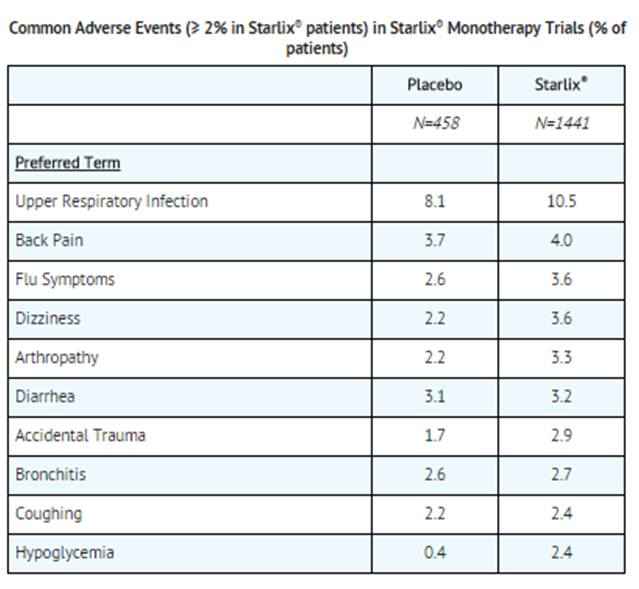
- During post-marketing experience, rare cases of hypersensitivity reactions such as rash, itching and urticaria have been reported. Similarly, cases of jaundice, cholestatic hepatitis and elevated liver enzymes have been reported.
Laboratory Abnormalities
- Uric Acid: There were increases in mean uric acid levels for patients treated with Starlix alone, Starlix in combination with metformin, metformin alone, and glyburide alone. The respective differences from placebo were 0.29 mg/dL, 0.45 mg/dL, 0.28 mg/dL, and 0.19 mg/dL. The clinical significance of these findings is unknown.
Postmarketing Experience
There is limited information regarding Postmarketing Experience of Nateglinide in the drug label.
Body as a Whole
Cardiovascular
Digestive
Endocrine
Hematologic and Lymphatic
Metabolic and Nutritional
Musculoskeletal
Neurologic
Respiratory
Skin and Hypersensitivy Reactions
Special Senses
Urogenital
Miscellaneous
Drug Interactions
Laboratory Tests
- Response to therapies should be periodically assessed with glucose values and HbA1C levels.
Drug Interactions
- Nateglinide is highly bound to plasma proteins (98%), mainly albumin. In vitro displacement studies with highly protein-bound drugs such as furosemide, propranolol, captopril, nicardipine, pravastatin, glyburide, warfarin, phenytoin, acetylsalicylic acid, tolbutamide, and metformin showed no influence on the extent of nateglinide protein binding. Similarly, nateglinide had no influence on the serum protein binding of propranolol, glyburide, nicardipine, warfarin, phenytoin, acetylsalicylic acid, and tolbutamide in vitro. However, prudent evaluation of individual cases is warranted in the clinical setting.
- Certain drugs, including nonsteroidal anti-inflammatory agents (NSAIDs), salicylates, monoamine oxidase inhibitors, non-selective beta-adrenergic-blocking agents, guanethidine, and CYP2C9 inhibitors (e.g. fluconazole, amiodarone, miconazole, oxandrolone) may potentiate the hypoglycemic action of Starlix and other oral antidiabetic drugs.
- Certain drugs including thiazides, corticosteroids, thyroid products, sympathomimetics, somatropin, rifampin, phenytoin and dietary supplements (St John’s wort) may reduce the hypoglycemic action of Starlix and other oral antidiabetic drugs. Somatostatin analogues may potentiate or attenuate the hypoglycemic action of Starlix.
- When these drugs are administered to or withdrawn from patients receiving Starlix, the patient should be observed closely for changes in glycemic control.
Drug/Food Interactions
- The pharmacokinetics of nateglinide were not affected by the composition of a meal (high protein, fat, or carbohydrate). However, peak plasma levels were significantly reduced when Starlix was administered 10 minutes prior to a liquid meal. Starlix did not have any effect on gastric emptying in healthy subjects as assessed by acetaminophen testing.
Use in Specific Populations
Pregnancy
- Nateglinide was not teratogenic in rats at doses up to 1000 mg/kg (approximately 60 times the human therapeutic exposure with a recommended Starlix dose of 120 mg, three times daily before meals). In the rabbit, embryonic development was adversely affected and the incidence of gallbladder agenesis or small gallbladder was increased at a dose of 500 mg/kg (approximately 40 times the human therapeutic exposure with a recommended Starlix dose of 120 mg, three times daily before meals). There are no adequate and well-controlled studies in pregnant women. Starlix should not be used during pregnancy.
- Australian Drug Evaluation Committee (ADEC) Pregnancy Category
There is no Australian Drug Evaluation Committee (ADEC) guidance on usage of Nateglinide in women who are pregnant.
Labor and Delivery
There is no FDA guidance on use of Nateglinide during labor and delivery.
Nursing Mothers
- Studies in lactating rats showed that nateglinide is excreted in the milk; the AUC0-48h ratio in milk to plasma was approximately 1:4. During the peri- and postnatal period body weights were lower in offspring of rats administered nateglinide at 1000 mg/kg (approximately 60 times the human therapeutic exposure with a recommended Starlix dose of 120 mg, three times daily before meals). It is not known whether Starlix is excreted in human milk. Because many drugs are excreted in human milk, Starlix should not be administered to a nursing woman.
Pediatric Use
There is no FDA guidance on the use of Nateglinide with respect to pediatric patients.
Geriatic Use
- No differences were observed in safety or efficacy of Starlix between patients age 65 and over, and those under age 65. However, greater sensitivity of some older individuals to Starlix therapy cannot be ruled out.
Gender
There is no FDA guidance on the use of Nateglinide with respect to specific gender populations.
Race
There is no FDA guidance on the use of Nateglinide with respect to specific racial populations.
Renal Impairment
There is no FDA guidance on the use of Nateglinide in patients with renal impairment.
Hepatic Impairment
- Starlix should be used with caution in patients with moderate-to-severe liver disease because such patients have not been studied.
Females of Reproductive Potential and Males
There is no FDA guidance on the use of Nateglinide in women of reproductive potentials and males.
Immunocompromised Patients
There is no FDA guidance one the use of Nateglinide in patients who are immunocompromised.
Administration and Monitoring
Administration
- Oral
Monitoring
There is limited information regarding Monitoring of Nateglinide in the drug label.
- Description
IV Compatibility
There is limited information regarding IV Compatibility of Nateglinide in the drug label.
Overdosage
- In a clinical study in patients with Type 2 diabetes, Starlix® (nateglinide) was administered in increasing doses up to 720 mg a day for 7 days and there were no clinically significant adverse events reported. There have been no instances of overdose with Starlix in clinical trials. However, an overdose may result in an exaggerated glucose-lowering effect with the development of hypoglycemic symptoms. Hypoglycemic symptoms without loss of consciousness or neurological findings should be treated with oral glucose and adjustments in dosage and/or meal patterns. Severe hypoglycemic reactions with coma, seizure, or other neurological symptoms should be treated with intravenous glucose. As nateglinide is highly protein bound, dialysis is not an efficient means of removing it from the blood.
Pharmacology
 | |
| Clinical data | |
|---|---|
| Trade names | Starlix |
| AHFS/Drugs.com | Monograph |
| MedlinePlus | a699057 |
| [[Regulation of therapeutic goods |Template:Engvar data]] |
|
| Routes of administration | Oral |
| ATC code | |
| Legal status | |
| Legal status | |
| Pharmacokinetic data | |
| Protein binding | 98% |
| Elimination half-life | 1.5 hours |
| Identifiers | |
| |
| CAS Number | |
| PubChem CID | |
| DrugBank | |
| ChemSpider | |
| UNII | |
| KEGG | |
| ChEBI | |
| ChEMBL | |
| E number | {{#property:P628}} |
| ECHA InfoCard | {{#property:P2566}}Lua error in Module:EditAtWikidata at line 36: attempt to index field 'wikibase' (a nil value). |
| Chemical and physical data | |
| Formula | C19H27NO3 |
| Molar mass | 317.423 g/mol |
| 3D model (JSmol) | |
| |
| |
| | |
Mechanism of Action
- Nateglinide is an amino-acid derivative that lowers blood glucose levels by stimulating insulin secretion from the pancreas. This action is dependent upon functioning beta-cells in the pancreatic islets. Nateglinide interacts with the ATP-sensitive potassium (K+ATP) channel on pancreatic beta-cells. The subsequent depolarization of the beta cell opens the calcium channel, producing calcium influx and insulin secretion. The extent of insulin release is glucose dependent and diminishes at low glucose levels. Nateglinide is highly tissue selective with low affinity for heart and skeletal muscle.
Structure
- Starlix® (nateglinide) is an oral antidiabetic agent used in the management of Type 2 diabetes mellitus [also known as non-insulin dependent diabetes mellitus (NIDDM) or adult-onset diabetes]. Starlix, (-)-N-[(trans-4-isopropylcyclohexane)carbonyl]-D-phenylalanine, is structurally unrelated to the oral sulfonylurea insulin secretagogues.
The structural formula is as shown:
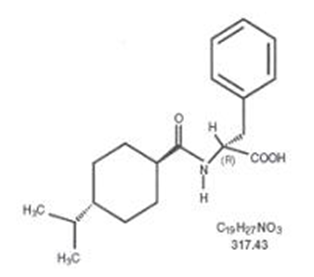
Pharmacodynamics
- Starlix is rapidly absorbed and stimulates pancreatic insulin secretion within 20 minutes of oral administration. When Starlix is dosed three times daily before meals there is a rapid rise in plasma insulin, with peak levels approximately 1 hour after dosing and a fall to baseline by 4 hours after dosing.
- In a double-blind, controlled clinical trial in which Starlix was administered before each of three meals, plasma glucose levels were determined over a 12-hour, daytime period after 7 weeks of treatment. Starlix was administered 10 minutes before meals. The meals were based on standard diabetic weight maintenance menus with the total caloric content based on each subject’s height. Starlix produced statistically significant decreases in fasting and postprandial glycemia compared to placebo.
Pharmacokinetics
Absorption
- Following oral administration immediately prior to a meal, nateglinide is rapidly absorbed with mean peak plasma drug concentrations (Cmax) generally occurring within 1 hour (Tmax) after dosing. When administered to patients with Type 2 diabetes over the dosage range 60 mg to 240 mg three times a day for one week, nateglinide demonstrated linear pharmacokinetics for both AUC (area under the time/plasma concentration curve) and Cmax. Tmax was also found to be independent of dose in this patient population. Absolute bioavailability is estimated to be approximately 73%. When given with or after meals, the extent of nateglinide absorption (AUC) remains unaffected. However, there is a delay in the rate of absorption characterized by a decrease in Cmax and a delay in time to peak plasma concentration (Tmax). Plasma profiles are characterized by multiple plasma concentration peaks when nateglinide is administered under fasting conditions. This effect is diminished when nateglinide is taken prior to a meal.
Distribution
- Based on data following intravenous (IV) administration of nateglinide, the steady-state volume of distribution of nateglinide is estimated to be approximately 10 liters in healthy subjects. Nateglinide is extensively bound (98%) to serum proteins, primarily serum albumin, and to a lesser extent α1 acid glycoprotein. The extent of serum protein binding is independent of drug concentration over the test range of 0.1-10 µg/mL.
Metabolism
- Nateglinide is metabolized by the mixed-function oxidase system prior to elimination. The major routes of metabolism are hydroxylation followed by glucuronide conjugation. The major metabolites are less potent antidiabetic agents than nateglinide. The isoprene minor metabolite possesses potency similar to that of the parent compound nateglinide.
- In vitro data demonstrate that nateglinide is predominantly metabolized by cytochrome P450 isoenzymes CYP2C9 (70%) and CYP3A4 (30%).
Excretion
- Nateglinide and its metabolites are rapidly and completely eliminated following oral administration. Within 6 hours after dosing, approximately 75% of the administered 14C-nateglinide was recovered in the urine. Eighty-three percent of the 14C-nateglinide was excreted in the urine with an additional 10% eliminated in the feces. Approximately 16% of the 14C-nateglinide was excreted in the urine as parent compound. In all studies of healthy volunteers and patients with Type 2 diabetes, nateglinide plasma concentrations declined rapidly with an average elimination half-life of approximately 1.5 hours. Consistent with this short elimination half-life, there was no apparent accumulation of nateglinide upon multiple dosing of up to 240 mg three times daily for 7 days.
Drug Interactions=
- In vitro drug metabolism studies indicate that Starlix is predominantly metabolized by the cytochrome P450 isozyme CYP2C9 (70%) and to a lesser extent CYP3A4 (30%). Starlix is a potential inhibitor of the CYP2C9 isoenzyme in vivo as indicated by its ability to inhibit the in vitro metabolism of tolbutamide. Inhibition of CYP3A4 metabolic reactions was not detected in in vitro experiments.
- Glyburide:
- In a randomized, multiple-dose crossover study, patients with Type 2 diabetes were administered 120 mg Starlix three times a day before meals for 1 day in combination with glyburide 10 mg daily. There were no clinically relevant alterations in the pharmacokinetics of either agent.
- Metformin:
- When Starlix 120 mg three times daily before meals was administered in combination with metformin 500 mg three times daily to patients with Type 2 diabetes, there were no clinically relevant changes in the pharmacokinetics of either agent.
- Digoxin:
- When Starlix 120 mg before meals was administered in combination with a single 1-mg dose of digoxin to healthy volunteers, there were no clinically relevant changes in the pharmacokinetics of either agent.
- Warfarin:
- When healthy subjects were administered Starlix 120 mg three times daily before meals for four days in combination with a single dose of warfarin 30 mg on day 2, there were no alterations in the pharmacokinetics of either agent. Prothrombin time was not affected.
- Diclofenac:
- Administration of morning and lunch doses of Starlix 120 mg in combination with a single 75-mg dose of diclofenac in healthy volunteers resulted in no significant changes to the pharmacokinetics of either agent.
Special Populations
- Geriatric:
- Age did not influence the pharmacokinetic properties of nateglinide. Therefore, no dose adjustments are necessary for elderly patients.
- Gender:
- No clinically significant differences in nateglinide pharmacokinetics were observed between men and women. Therefore, no dose adjustment based on gender is necessary.
- Race:
- Results of a population pharmacokinetic analysis including subjects of Caucasian, Black, and other ethnic origins suggest that race has little influence on the pharmacokinetics of nateglinide.
- Renal Impairment:
- Compared to healthy matched subjects, patients with Type 2 diabetes and moderate-to-severe renal insufficiency (CrCl 15-50 mL/min) not on dialysis displayed similar apparent clearance, AUC, and Cmax. Patients with Type 2 diabetes and renal failure on dialysis exhibited reduced overall drug exposure. However, hemodialysis patients also experienced reductions in plasma protein binding compared to the matched healthy volunteers.
- Hepatic Impairment:
- The peak and total exposure of nateglinide in non-diabetic subjects with mild hepatic insufficiency were increased by 30% compared to matched healthy subjects. Starlix® (nateglinide) should be used with caution in patients with chronic liver disease.
Nonclinical Toxicology
Carcinogenesis/Mutagenesis/Impairment of Fertility
- Carcinogenicity: A two-year carcinogenicity study in Sprague-Dawley rats was performed with oral doses of nateglinide up to 900 mg/kg/day, which produced AUC exposures in male and female rats approximately 30 and 40 times the human therapeutic exposure respectively with a recommended Starlix dose of 120 mg, three times daily before meals. A two-year carcinogenicity study in B6C3F1 mice was performed with oral doses of nateglinide up to 400 mg/kg/day, which produced AUC exposures in male and female mice approximately 10 and 30 times the human therapeutic exposure with a recommended Starlix dose of 120 mg, three times daily before meals. No evidence of a tumorigenic response was found in either rats or mice.
Mutagenesis
- Nateglinide was not genotoxic in the in vitro Ames test, mouse lymphoma assay, chromosome aberration assay in Chinese hamster lung cells, or in the in vivo mouse micronucleus test.
Impairment of Fertility:
- Fertility was unaffected by administration of nateglinide to rats at doses up to 600 mg/kg (approximately 16 times the human therapeutic exposure with a recommended Starlix dose of 120 mg three times daily before meals).
Clinical Studies
- A total of 3,566 patients were randomized in nine double-blind, placebo- or active-controlled studies 8 to 24 weeks in duration to evaluate the safety and efficacy of Starlix® (nateglinide). 3,513 patients had efficacy values beyond baseline. In these studies Starlix was administered up to 30 minutes before each of three main meals daily.
Starlix® Monotherapy Compared to Placebo
- In a randomized, double-blind, placebo-controlled, 24-week study, patients with Type 2 diabetes with HbA1C ≥ 6.8% on diet alone were randomized to receive either Starlix (60 mg or 120 mg three times daily before meals) or placebo. Baseline HbA1C ranged from 7.9% to 8.1% and 77.8% of patients were previously untreated with oral antidiabetic therapy. Patients previously treated with antidiabetic medications were required to discontinue that medication for at least 2 months before randomization. The addition of Starlix before meals resulted in statistically significant reductions in mean HbA1C and mean fasting plasma glucose (FPG) compared to placebo (see Table 1). The reductions in HbA1C and FPG were similar for patients naïve to, and those previously exposed to, antidiabetic medications.
- In this study, one episode of severe hypoglycemia (plasma glucose < 36 mg/dL) was reported in a patient treated with Starlix 120 mg three times daily before meals. No patients experienced hypoglycemia that required third party assistance. Patients treated with Starlix had statistically significant mean increases in weight compared to placebo (see Table 1).
- In another randomized, double-blind, 24-week, active- and placebo-controlled study, patients with Type 2 diabetes were randomized to receive Starlix (120 mg three times daily before meals), metformin 500 mg (three times daily), a combination of Starlix 120 mg (three times daily before meals) and metformin 500 mg (three times daily), or placebo. Baseline HbA1C ranged from 8.3% to 8.4%. Fifty-seven percent of patients were previously untreated with oral antidiabetic therapy. Starlix monotherapy resulted in significant reductions in mean HbA1C and mean FPG compared to placebo that were similar to the results of the study reported above (see Table 2).
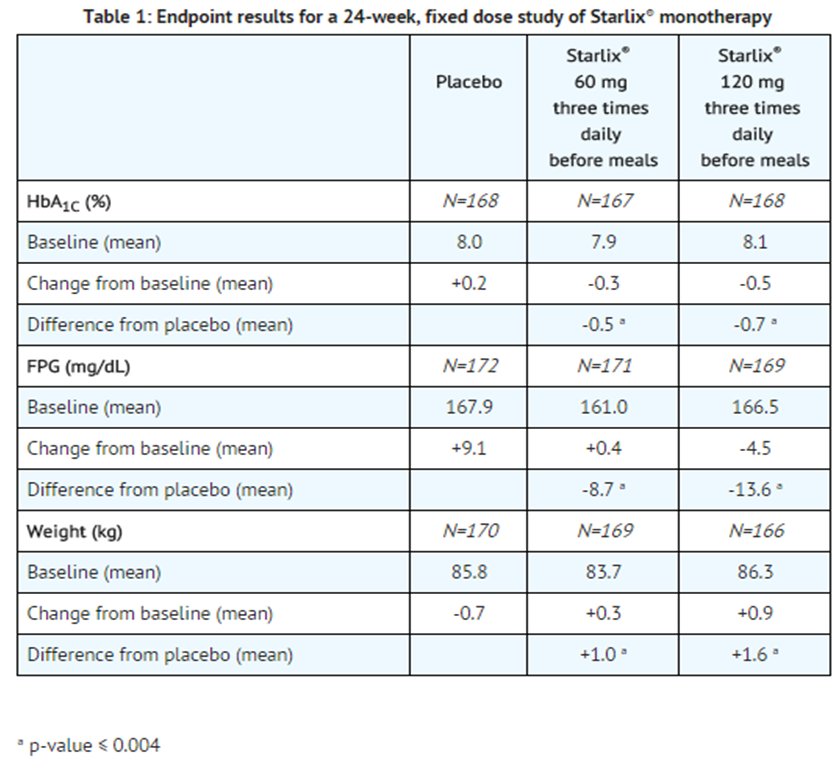
Starlix® Monotherapy Compared to Other Oral Antidiabetic Agents
- Glyburide
- In a 24-week, double-blind, active-controlled trial, patients with Type 2 diabetes who had been on a sulfonylurea for ≥ 3 months and who had a baseline HbA1C ≥ 6.5% were randomized to receive Starlix (60 mg or 120 mg three times daily before meals) or glyburide 10 mg once daily. Patients randomized to Starlix had significant increases in mean HbA1C and mean FPG at endpoint compared to patients randomized to glyburide.
- Metformin
- In another randomized, double-blind, 24-week, active- and placebo-controlled study, patients with Type 2 diabetes were randomized to receive Starlix (120 mg three times daily before meals), metformin 500 mg (three times daily), a combination of Starlix 120 mg (three times daily before meals) and metformin 500 mg (three times daily), or placebo. Baseline HbA1C ranged from 8.3% to 8.4%. Fifty-seven percent of patients were previously untreated with oral antidiabetic therapy. Patients previously treated with antidiabetic medications were required to discontinue medication for at least 2 months before randomization. The reductions in mean HbA1C and mean FPG at endpoint with metformin monotherapy were significantly greater than the reductions in these variables with Starlix monotherapy (see Table 2). Relative to placebo, Starlix monotherapy was associated with significant increases in mean weight whereas metformin monotherapy was associated with significant decreases in mean weight. Among the subset of patients naïve to antidiabetic therapy, the reductions in mean HbA1C and mean FPG for Starlix monotherapy were similar to those for metformin monotherapy (see Table 2). Among the subset of patients previously treated with other antidiabetic agents, primarily glyburide, HbA1C in the Starlix monotherapy group increased slightly from baseline, whereas HbA1C was reduced in the metformin monotherapy group (see Table 2).
Starlix® Combination Therapy
- Metformin
- In the active and placebo-controlled study of metformin and Starlix described above, the combination of Starlix and metformin resulted in statistically significantly greater reductions in HbA1C and FPG compared to either Starlix or metformin monotherapy (see Table 2). Starlix, alone or in combination with metformin, significantly reduced the prandial glucose elevation from pre-meal to 2-hours post-meal compared to placebo and metformin alone.
- In this study, one episode of severe hypoglycemia (plasma glucose ≤ 36 mg/dL) was reported in a patient receiving the combination of Starlix and metformin and four episodes of severe hypoglycemia were reported in a single patient in the metformin treatment arm. No patient experienced an episode of hypoglycemia that required third party assistance. Compared to placebo, Starlix monotherapy was associated with a statistically significant increase in weight, while no significant change in weight was observed with combined Starlix and metformin therapy (see Table 2).
- In another 24-week, double-blind, placebo-controlled trial, patients with Type 2 diabetes with HbA1C ≥ 6.8% after treatment with metformin (≥ 1500 mg daily for ≥ 1 month) were first entered into a four week run-in period of metformin monotherapy (2000 mg daily) and then randomized to receive Starlix (60 mg or 120 mg three times daily before meals) or placebo in addition to metformin. Combination therapy with Starlix and metformin was associated with statistically significantly greater reductions in HbA1C compared to metformin monotherapy (-0.4% and -0.6% for Starlix 60 mg and Starlix 120 mg plus metformin, respectively).
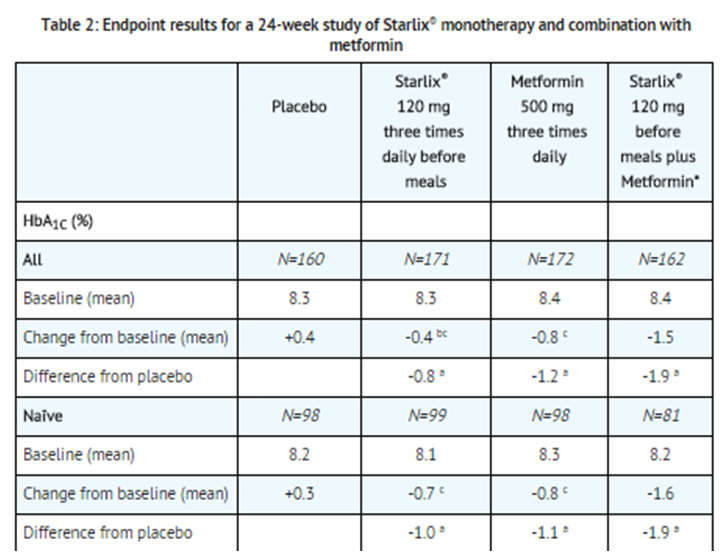
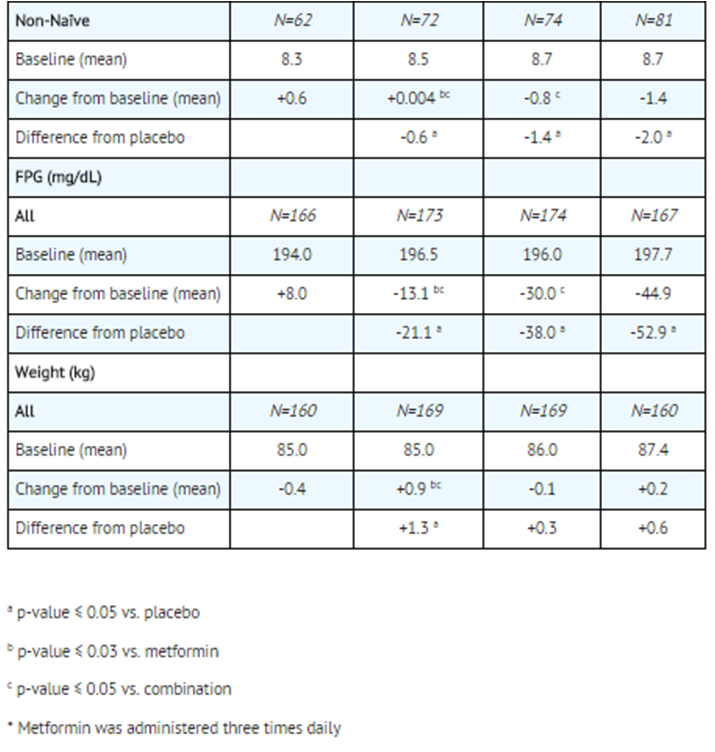
- Rosiglitazone
- A 24-week, double blind multicenter, placebo-controlled trial was performed in patients with Type 2 diabetes not adequately controlled after a therapeutic response to rosiglitazone monotherapy 8 mg daily. The addition of Starlix (120 mg three times per day with meals) was associated with statistically significantly greater reductions in HbA1C compared to rosiglitazone monotherapy. The difference was -0.77% at 24 weeks. The mean change in weight from baseline was about +3 kg for patients treated with Starlix plus rosiglitazone vs about +1 kg for patients treated with placebo plus rosiglitazone.
- Glyburide
- In a 12-week study of patients with Type 2 diabetes inadequately controlled on glyburide 10 mg once daily, the addition of Starlix (60 mg or 120 mg three times daily before meals) did not produce any additional benefit.
How Supplied
Starlix® (nateglinide) tablets
60 mg
Pink, round, beveled edge tablet with “STARLIX” debossed on one side and “60” on the other.
Bottles of 100……………………………………………….NDC 0078-0351-05
120 mg
Yellow, ovaloid tablet with “STARLIX” debossed on one side and “120” on the other.
Bottles of 100……………………………………………….NDC 0078-0352-05
Manufactured by: Novartis Singapore Pharmaceutical Manufacturing Pte. Ltd., Singapore 637461
Distributed by: Novartis Pharmaceuticals Corporation East Hanover, New Jersey 07936
©Novartis
T2013-06 January 2013
Storage
- Store at 25ºC (77ºF); excursions permitted to 15ºC-30ºC (59ºF-86ºF).
- Dispense in a tight container, USP.
Images
Drug Images
{{#ask: Page Name::Nateglinide |?Pill Name |?Drug Name |?Pill Ingred |?Pill Imprint |?Pill Dosage |?Pill Color |?Pill Shape |?Pill Size (mm) |?Pill Scoring |?NDC |?Drug Author |format=template |template=DrugPageImages |mainlabel=- |sort=Pill Name }}
Package and Label Display Panel
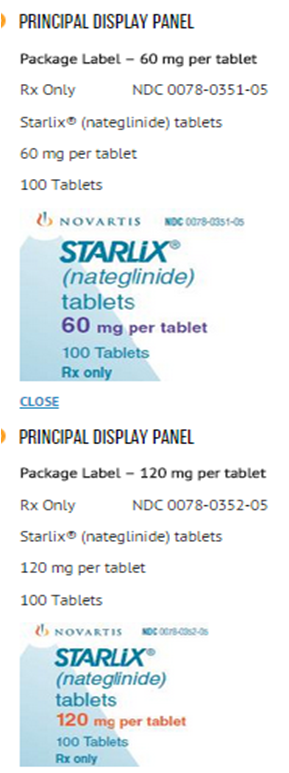
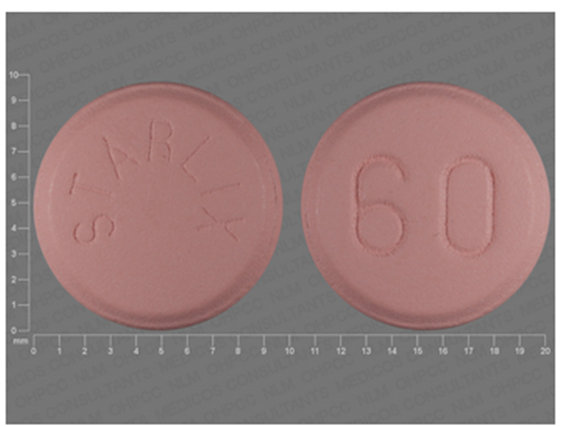
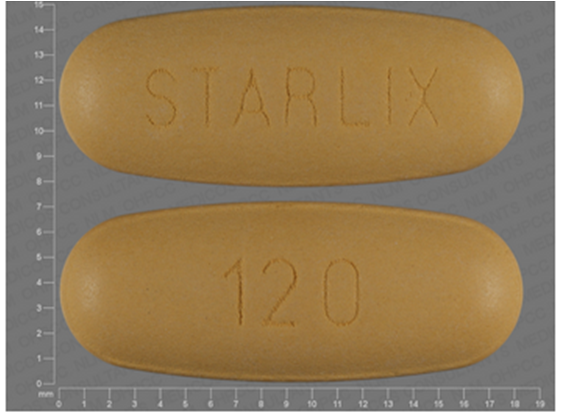
{{#ask: Label Page::Nateglinide |?Label Name |format=template |template=DrugLabelImages |mainlabel=- |sort=Label Page }}
Patient Counseling Information
- Patients should be informed of the potential risks and benefits of Starlix and of alternative modes of therapy. The risks and management of hypoglycemia should be explained. Patients should be instructed to take Starlix 1 to 30 minutes before ingesting a meal, but to skip their scheduled dose if they skip the meal so that the risk of hypoglycemia will be reduced. Drug interactions should be discussed with patients. Patients should be informed of potential drug-drug interactions with Starlix.
Precautions with Alcohol
- Hypoglycemia: All oral blood glucose lowering drugs that are absorbed systemically are capable of producing hypoglycemia. The frequency of hypoglycemia is related to the severity of the diabetes, the level of glycemic control, and other patient characteristics. Geriatric patients, malnourished patients, and those with adrenal or pituitary insufficiency or severe renal impairment are more susceptible to the glucose lowering effect of these treatments. The risk of hypoglycemia may be increased by strenuous physical exercise, ingestion of alcohol, insufficient caloric intake on an acute or chronic basis, or combinations with other oral antidiabetic agents. Hypoglycemia may be difficult to recognize in patients with autonomic neuropathy and/or those who use beta-blockers. Starlix® (nateglinide) should be administered prior to meals to reduce the risk of hypoglycemia. Patients who skip meals should also skip their scheduled dose of Starlix to reduce the risk of hypoglycemia.
Brand Names
- Starlix®
Look-Alike Drug Names
There is limited information regarding Nateglinide Look-Alike Drug Names in the drug label.
Drug Shortage Status
Price
References
The contents of this FDA label are provided by the National Library of Medicine.
{{#subobject:
|Page Name=Nateglinide
|Pill Name=No image.jpg
|Drug Name=
|Pill Ingred=|+sep=;
|Pill Imprint=
|Pill Dosage={{{dosageValue}}} {{{dosageUnit}}}
|Pill Color=|+sep=;
|Pill Shape=
|Pill Size (mm)=
|Pill Scoring=
|Pill Image=
|Drug Author=
|NDC=
}}
{{#subobject:
|Label Page=Nateglinide |Label Name=Nateglinide11.png
}}
{{#subobject:
|Label Page=Nateglinide |Label Name=Nateglinide11.png
}}
- Pages with script errors
- Template:drugs.com link with non-standard subpage
- Articles with changed KEGG identifier
- Articles with changed EBI identifier
- E number from Wikidata
- ECHA InfoCard ID from Wikidata
- Chemical articles with unknown parameter in Infobox drug
- Drug has EMA link
- Drugboxes which contain changes to verified fields
- Drug